Email John Vonderlin: [email protected]
Here’s a Frank Brophy ad for Princeton-by-the-Sea, circa 1908
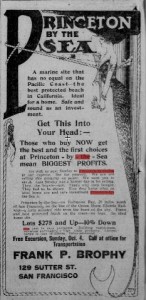


Created by June Morrall
Email John Vonderlin: [email protected]
Here’s a Frank Brophy ad for Princeton-by-the-Sea, circa 1908


Story by John Vonderlin
Email John: [email protected]
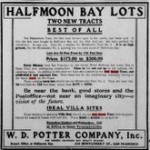

W. D. Potter Company, Inc. selling HALF MOON BAY LOTS
TWO NEW TRACTS
BEST OF ALL
The Miramontes Tract, the first tract thrown open to the public, has been sold. It was the first tract bought in Half Moon Bay and the first sold out. We have profited by experience. So may you. Tract No. 2 adjoins the Miramontes Tract No. 1. It is on high ground, like the Miramontes No. 1, opening into the main street of Half Moon Bay.
PRICES; $175 – $500
Be near the bank, good stores and the PostOffice–not near an imaginary city–a vision of the future
IDEAL VILLA SITES
[Image below: 1970s: Standing on a slab of the “Ocean Shore Highway” at El Granada.]
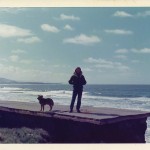
The Great Storm of 1926
by June Morrall
When J.O Richards, chief engineer at the Point Montara Light Station, drove toward Half Moon Bay on a rainy Friday morning in February of 1926, he encountered the unexpected.
As Richards cautiously made his way along the wind swept bluffs in the small resort town of Princeton, he veered to avoid piles of driftwood strewn across the roadway.
And, as the downpour steadily increased, he swerved to avoid the impact of a giant wave heading for the windshield of his car. Slowly, he ground the automobile to a halt. Richards was visibly shaken, and when he got out of the car and saw the shattered windshield, he knew he was lucky to have escaped physical injury.
The next morning local newspapers described the alterations to the shoreline caused by “the worst storm in the Coastside’s history.”
A combination of driving rain and heavy seas savaged the stretch of coastline between Princeton and Miramar, heralded by Ocean Shore Railroad publicists in the early 1900s as one of the safest and most beautiful beaches.
The 1926 storm left its ugly mark on the beaches but some locals still remembered the whipping rain and wind of 1887 that claimed the Centennial Flag, then the pride of Half Moon Bay.The beloved flagpole toppled from its base and crashed through the ceiling of the Ames Saloon. At the time, the owner was out for breakfast and fortunately no one was hurt. But the saloon’s fancy chandeliers and lamps lay cracked and splintered across the wooden floor.
Although treated with wood preservatives, the flag pole, more than 100-feet tall, had rotted off at the ground and broke into several pieces. When it fell, the pole severed the town’s telegraph wires, temporarily cutting Half Moon Bay off from chatter with the rest of the county.
But in 1926 the storm’s most painful damage centered around the Prohibition beach resorts of Princeton and Granada where the powerful waves relentlessly smashed the fragile cliffs. In some places, the erosion reduced the distance between beach and the “Ocean Shore Highway” from 25-feet to a few inches.
You may not know that in the 1920s the road from San Francisco to Half Moon Bay followed a slightly different route than it does today. The highway 1 we are familiar with today was completed in the 1950s. But during Prohibition, beginning, say, at Montara, the Ocean Shore Highway turned east on Main Street, passing through Moss Beach along Etheldore Street. Then the road skimmed over flat country until reaching Princeton, with its three piers, where it turned south along Capistrano Road, following the shoreline for a short distance.
In Granada, the road turned eastward on Alhambra Avenue, then heading west into hotel-lined Miramar–where, in the 1970s, sections of the old crumbling roadway could be seen on the strand between El Granada and Miramar. Passing through the Coastside’s rich artichoke growing district, the Ocean Shore Highway reached Half Moon Bay.
Some oldtimers claimed the high tide at 9:30 a.m. on that morning in February 1926 was the highest level ever seen on the Coastside. For hours, big wave after big wave pounded the cliffs. And every third or fourth or fifth wave splashed up and over the highway, leaving behind a rubble of driftwood and pebbles,closing the roadway until workers arrived to clear away the debris.
The ocean’s waves swamped Artichoke King Dante Dianda’s ranch in Granada, and the land he farmed nearest Pillar Point Breakwater has vanished completely, eaten up by the sea. But For Dianda, worse was yet to come. Two months after the February storm, a large dam located on Dianda’s property in the back of Granada, burst, sending thousands of gallons of water spilling down the mountain-side. The tremendous water pressure pushed a vacation home some 600 feet from its original position. For hours 12 inches of slushy mud covered the roadway between Princeton and Granada.
During the Great Storm of 1926, piles of driftwood washed to within five feet of the popular Patroni House operated by Giovanni (John) Patroni, a prominent businessman and Coastside resident since 1902.
Also in Princeton, rogue waves wrecked both the 1000-foot Henry Cowell Wharf (which I think stood near Hazels, now Barbara’s FishTrap), and cement manufacturer Cowell’s warehouse. A small fish market, belonging to J.S. Bettencourt, was damaged beyond reognition and a donkey engine and pile driver were swept into the sea.
In Moss Beach, right there on the sandy beach, Charlie Nye’s famous “Reefs” lost its dancing platform, which was swept away. Nye always enjoyed telling guests that he had entertained the likes of author Jack London and horticulturist Luther Burbank. In Miramar, the once historic shipping wharf that could be seen from the big picture windows of Joe Miguel’s Palace Miramar Hotel lost a section of essential decking, leaving an empty space where there had been a connection to the mainland.
A month later when another devastating storm visited the Coastside, a combination of heavy rain and seas pummeled the Princeton=Granada-Miramar roadway, forcing automobile traffic to take a detour. By now only a few feet remained between the Ocean Shore Highway and the cliffs and there was a 30 to 40 foot drop to the beach below. Officials revealed plans to relocate this stretch of roadway, constructing what we know today as the beautiful shoreline highway running the length of California.
But both John Patroni and Dante Dianda strongly resisted change. They did not want to alter the roadway as it then existed, even if the storm was chewing up the cliffs. As they argued that Princeton’s hotels depended upon tourists using the old, shrinking road, the bad weather continued to force temporary closure of the Princeton-Granada-Miramar thoroughfare.
In a desperate attempt to save what Dianda and Patroni called “the prettiest and safest bathing beach on the Pacific Coast,” the farmer and the roadhouse owner offered San Mateo County officials the land necessary for construction of the new highway asking only that they build it as close as possible to its original location. To protect the new highway, they recommended building a sturdy rock retaining wall. Dianda and Patroni had the full support of the community; “roadviewers,” they were called, “voted” to keep the new road in the old location. But instead of curving into and out of the Ocean Shore Railroad- era towns of yesterday, when Highway 1 was finally completed in the 1950s, the new ribbon of road completely ignored them, looking neither east nor west, but just straight ahead.
Story by Barry Parr, Coastsider.com
Dear Coastsider Reader:
Power is down in our part of Montara, and we’ve set up shop at Caffe
Lucca on Highway 1, where they still have power and Internet access.
Share your reports of the Great Storm of ‘09 in comments on this topic,
or send us your photos and we’ll post them.
In the meantime, keep dry and stay home if you can.
Stormy Weather
by Michaele Benedict
Our tiny north room, ten feet by twelve with five windows, is the place to be during a storm.
If you sit in just the right spot, you can see the waves of the Pacific crashing at the foot of Montara Mountain. You can see the blurred images of cars driving over the Slide, following the watery reflections of their own headlights on the road. It is an impressionist painting, seen through the wavery old glass windows, soft-edged and nuanced.
A battery radio and most of the candles are in here in case the power goes out. You could survive quite a while on the jam and chutney stacked atop the cupboard. The family pictures are here, as well as 20-something Byzantine ikons, in case you need a meditative moment.
Here, through some quirk of reflection in the window at right angles to the bathroom window, we can see the traffic pass by on Sixth Street, though the street itself is above sight level if you try to look at it directly.
We spend most of our time in this room anyway, since the north light is good for painting and the dining room table and my desk and computer are here.
The room is also the farthest away from the cypresses, which have a dismaying way of dropping big branches on the car and house during a storm. We have 19 of them and a 100-foot log fence four feet tall made from fallen limbs and the trees which have had to be removed. The grandfather of all cypresses, 70 feet tall and 14 feet around the trunk, grows a scant dozen feet from my piano in the front room, its root system probably spanning the entire foundation of the house.
Thanks to more tree work than I can describe, thinning, pruning, removing fallen and falling branches, storms now produce mostly wind music from the thrashing limbs and a rain of cypress cones and needles.
Our most spectacular cypress incident occurred during a December storm when I lived across the street, where there were only five or six cypresses. In the middle of the night, I was awakened by a loud noise and a violent shaking. Groggily, I turned on the bedside lamp and wondered why the ceiling had turned green.
When I put on my glasses, I saw that a cypress branch had fallen on the skylight directly above the bed, had shattered the skylight and come through the ceiling, stopping a few feet from where I lay sleeping.
It was pretty, like a Christmas tree hanging from the ceiling, and it smelled wonderful. When we went outside in the morning, we saw that we had had a very narrow escape.
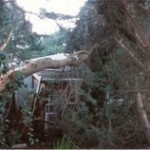
———————————
Michaele (Mikie) Benedict is the author of “Searching for Anna”
To visit Mikie’s blog, Writeritewrightright.blogspot.com, please click here
Email Michaele: [email protected]
DAYLIGHT ARRIVED WITH twenty knots of southwest wind. Already the ocean was littered with white caps, and these were on top of the monster swells. I had arrived at the readings that indicated I was over the head of the sea canyon. The chromoscope depth finder showed that indeed the bottom had dropped off sharply from 100 fathoms to 300 fathoms in just a very short distance. Other than the jumbled seas, the ocean was lifeless. Normally there would be an abundance of bird life — seagulls, pelicans, murres — working for their breakfasts. But this day there were no birds. It gave me a dreadful feeling in the pit of an already queasy stomach. The marine weather radio had forecasted the 20-foot swells, but it had predicted only light wind.
I slowed the boat to an idle, and set a course that would run along one side of the sea canyon. It was a course that had the my salmon troller, the Pescadero, broadside to the towering seas, and within seconds it had drawers dumped out on the floor — drawer locks that had never ever come loose before, had failed with the sharp rolls the boat was taking. At once, the two cupboard locks also failed and their contents were flung out, adding to the confusion already on the cabin floor. The boat cabin was only a twelve by twelve area but smaller with the cabinets, a bunk, a stove, and the electronics and running seat at the forward end. Clyde, my golden retriever, had found a spot under the tiny galley table and lay there whimpering.
I changed to a better course, “I don’t think we’re going to get to fish today Clyde,” I said, and Clyde stopped whimpering as if that were the first good news he’d heard on what had so far been a portentous morning.
The better course had the boat idling directly into the wind and sea; however this was the opposite direction of home. And home is where I wanted more than ever to go now.
But I knew I must remain on this course, at least for the moment, in order to could get the situation back under control: The whole thing was slipping quickly away.
I picked up arm loads of stuff off of the floor, and dumped it in whatever drawer was handy. Larger stuff was shoved into the two cabinets, and all of the compartments were then nailed closed. I had a hammer and a coffee can full of assorted nails wedged in a cubby-hole beside the stove; and used a bag of bread, lunch meat, and fruit as a wedge.
And the churning seas tossed and heaved the tiny Pescadero mercilessly.
Clyde could not get any further into the corner under the table, and he was shivering now uncontrollably.
I took a handful of 16-penny nails out on the deck and proceeded to nail the several hatch covers on tight. Spit was blown right out of my mouth; eyelids were curled back by the velocity of the wind, and pellets of saltwater pelted like bullets from a gun: it was blowing 50 knots, all of a sudden, and the sea no longer had just white caps for it was one solid mass of white water, and the swells had grown to telephone-pole-size — about 30 feet tall.
I had never been on the ocean in conditions this bad, and wished to not be thhere now. But I had to get the boat, and myself, back home. This was a must do.
“I should have listened to everyone,” I said to Clyde on the way back in the back door and into the relative safety of the cabin. And none too soon — a mountainous comber, the size of a battleship, dumped so much green water onto the back deck that if I had been out there, I would surely now be washed overboard.
* *
I ALWAYS FELT like an intelligent man. Not complex, and nearly always stable. But on the trip back in, my thick eyebrows were raised, and a normally relaxed face was at a hard stare; tension obvious in my lower lids. The corners of my lower face were drawn back, and normally full lips were stretched taut.
“I’m sorry Clyde!” I was scared shitless, and Clyde was actually crying real tears; the pathetic dog had become too afraid to whimper any longer. I had given him a piece of lunch meat, which was still there on the floor uneaten. And every time I put a small bowl of water under Clyde’s nose, he ignored that too.
The Pescadero pitched from one side to the other in the following sea. I rode the throttle looking, meanwhile, out the back window at what was coming up on my stern. When another big mountain would loom, I’d slow down and grab the wheel — taking the boat off auto-pilot for a moment — so I could hand-steer while literally surfing down the face of the tremendous swells.
One towering monster picked up the stern then buried the nose of the boat, then spun the boat around so fast that I was sure that this was it. I said to Clyde, “This is a wicked storm, Clyde, and we’ll be damn lucky if we can get us home.”
The situation was out of control and I, sweating profusely, was hanging on by a thread. My heart pounded every time the boat tipped and rolled, and breath came in gasps; I was dizzy and claustrophobic — I suffer from fear of heights, besides close spaces — and I’d puked in the small sink several times when the boat rose to the crest of a giant swell. Normally the boat’s cabin would not trigger my close-space phobia, but today, with the back door nailed tightly shut the familiar symptoms were on me like a bad flu.
And I was dead tired from bracing for every pitch of the boat: this was like a wild and demented carnival ride…
—A modified excerpt from “John Dory and the Wicked Storm” by Rob Tillitz, author of “Bootlegger’s Cove” and “Eyes like Half Dollars”
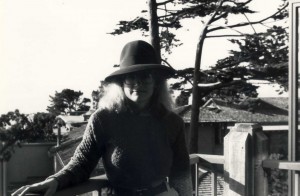
Who’s got the best windows to watch this week’s GREAT STORM from? Vote & Email me: [email protected].
Sam’s Chowder House (Highway 1, between Miramar, Princeton & Across the Road from El Granada). Beautifully remodeled, formerly the site of “Cannery Row” “Ida’s.” Every seat in the house gets an ocean/harbor view out of the Big Picture Windows. Great Storm Watching
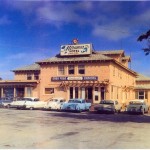 Miramar Beach Inn (Miramar Beach) Originally an early Prohibition-era roadhouse with a red-haired madam.. To watch the rain and wind, ask for a window seat. Window seats are limited but worth it for storm watching.
Miramar Beach Inn (Miramar Beach) Originally an early Prohibition-era roadhouse with a red-haired madam.. To watch the rain and wind, ask for a window seat. Window seats are limited but worth it for storm watching.
Moss Beach Distillery (Moss Beach) Originally a late Prohibition-era roadhouse with a bull ring motif on the floor of the bar. Big windows overlooking the famous Fitzgerald Marine Reserve, lots of vast ocean views. Ask for a window seat.
La Costanera (Montara Beach) Originally a circa 1950s restaurant owned by the Torres family, who also built the Distillery. When pummeled with wind and rain, Montara Beach is a scene to behold from the big floor-to-ceiling windows.
Mezza Luna (Princeton-by-the-Sea) Originally the Ocean Shore Railroad era Princeton Inn, a hotel. The most historical building in Princeton. Sit by the window and you will catch delightful views of the harbor.
Crab Landing (Princeton-by-the-Sea) New restaurant located in what was the center of Prohibition activity–and in the 1940s a small “Cannery Row.” Great storm views of the boats bobbing in the harbor from all the seats in the house. Big Windows.
Vote now! Which one’s the best to watch this week’s GREAT STORM from?
What’d I miss?
————–
Coastsider.com’s Barry Parr says:
Interesting question. I was trying to think of a less-expensive setting.
I visited the opening of La Costanera, and it looks like the view of the storm should be spectacular from the bluff overlooking Montara Beach. It has been close to ten years since I’ve been in that building. I visited the Charthouse once and that was plenty. But with the new menu, I think plenty of Coastsiders will be rediscovering this setting.
If you don’t mind getting wet and blown about, the bluff above the Fitzgerald Marine Reserve might be an interesting choice. It was the setting for a spectacular storm scene at the beginning of “Memoirs of a Geisha”
to view the scene, please click here: http://coastsider.ultralocal.com/gallery/index.php?album=Memoirs_of_a_Geishaℑ=IMG_2620_001.jpg
Barry Parr: coastsider.com
—————————–
 Deb & Michael Wong from Spring Mountain Gallery Says:
Deb & Michael Wong from Spring Mountain Gallery Says:
You covered all of the ones we first thought of. Michael & I brainstormed (ha ha – “stormed”), and since we both grew up in Pacifica, can’t leave out Nick’s Coctail Lounge, or Ristorante Portofino in the Best Western Lighthouse Hotel. Both restaurants have huge windows & ocean views.
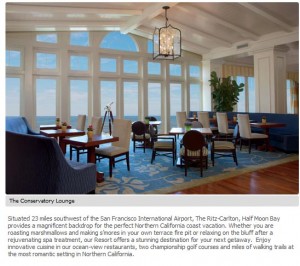
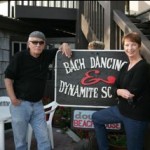
 Explorer John Vonderlin says:
Explorer John Vonderlin says:Jennifer Castner says:
Hi June!
Not that I’ve been to Costanera yet, but that’d be my pick for best storm-watching location.
Hope the storm lives up to at least some of the hype!
————————-
Sharon Bertolucci (President, Cypress Ridge Appraisal Service, Moss Beach) says:
Hi June,
I don’t really know, unless you want to sit in your car over on Vallemar Street in Moss Beach, or over by Maverick’s in the car?! You got them all that I can think of,,,,,,oh maybe by the new restaurant in Montara!
……….Where the HMB Brewing Company was the other Ida’s only it was a much smaller building then…….Take Care stay Dry!
Have Fun, watching the storm!
———————
Anonymous says:
The best place to watch the storm is from a boat, close enough to see the shore, but far enough out to have a 360 degree view. The second best place to watch the storm is from the Oceano Hotel and Spa. There are two rooms with windows on two sides. I don’t remember their numbers but they are around 315. If the storm gets vigorous enough, you may even get some water from under the door.
———————————
Artist Susan Friedman says:
Hi June,
I think the beat place to watch the storm in my Studio on the Mountain curled up by the fire….Best, Susan
Studio on the Mountain
Tonight on Madmen
June Asks: Who’s having a better time?
Mr Francis to 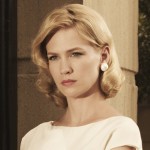 Mrs. Draper: “I don’t know what you want, Betty.” I give her points for throwing the cash box at his head. Too bad he ducked. Mr. Francis, the right hand man to the politician, Rockefeller, says to a fantasy- frustrated Betty–who had worn a beautiful dress with a low cut back at a fundraiser she hosted, and that he, Francis, strategically did not attend– “You had to come to me.” He closes and locks his office door. “Why?” asks Betty, who’s looking for revenge and the locked door could be the excuse. “Because you’re married,” he said.
Mrs. Draper: “I don’t know what you want, Betty.” I give her points for throwing the cash box at his head. Too bad he ducked. Mr. Francis, the right hand man to the politician, Rockefeller, says to a fantasy- frustrated Betty–who had worn a beautiful dress with a low cut back at a fundraiser she hosted, and that he, Francis, strategically did not attend– “You had to come to me.” He closes and locks his office door. “Why?” asks Betty, who’s looking for revenge and the locked door could be the excuse. “Because you’re married,” he said.
or
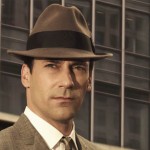 Don Draper to
Don Draper to  Sally, his daughter’s teacher: “What does it matter to a person like you?” And what kind of a person is Sally? Well, she’s single, spouts existentialist lines, lives above somebody’s garage, and when Don walked in, he said: “Nice place.”
Sally, his daughter’s teacher: “What does it matter to a person like you?” And what kind of a person is Sally? Well, she’s single, spouts existentialist lines, lives above somebody’s garage, and when Don walked in, he said: “Nice place.”
June Admits: This is familiar terrain. I’ve been down both of these roads before.
To view Taschen’s book offerings, please click here